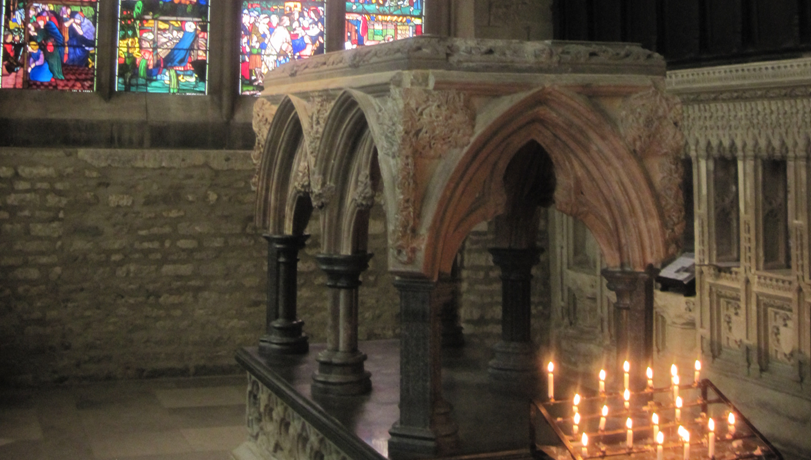 |
| The Catecheses of St. Cyril. The Procatecheses is the prologue. |
He is remembered for his scholarship in liturgy, his charity and as one of the greatest theologians of the 4th century as a definer and defender of the faith. Sometime during his episcopate he wrote the Catecheses, eighteen lectures on the Christian faith to be preached to the catechumens, those waiting for baptism, and the five Mystagogical Catecheses, on the sacraments, for the newly baptized. For these works, Cyril earned his place among the early Church Fathers, and remains a source for those looking for definitions and explanations in Christianity as his works have survived and are widely known.
As the Emperor Constantine had only made the world safe for Christians in 315, Christian laypeople were coming from their cities with their bishops now freely able to visit the tombs of martyrs being erected and more significantly to travel to Jerusalem itself. Cyril provided for probably increasing numbers of pilgrims the Holy Week liturgies that are still used everywhere today, including the procession with palms on Palm Sunday.
The Episcopal Church cites the journal of a 4th century Spanish nun called Egeria, who came in contact with St. Cyril while in Jerusalem. Here is her account for the festivities on Palm Sunday:
"Accordingly at the seventh hour all the people go up to the Mount of Olives, that is, to Eleona, and the bishop with them, to the church, where hymns and antiphons suitable to the day and to the place are said, and lessons in like manner. And when the ninth hour approaches they go up with hymns to the Imbomon, that is, to the place whence the Lord ascended into heaven, and there they sit down, for all the people are always bidden to sit when the bishop is present; the deacons alone always stand. Hymns and antiphons suitable to the day and to the place are said, interspersed with lections and prayers. And as the eleventh hour approaches, the passage from the Gospel is read, where the children, carrying branches and palms, met the Lord, saying; Blessed is He that cometh in the name of the Lord, and the bishop immediately rises, and all the people with him, and they all go on foot from the top of the Mount of Olives, all the people going before him with hymns and antiphons, answering one to another: Blessed is He that cometh in the Name of the Lord. And all the children in the neighborhood even those who are too young to walk, are carried by their parents on their shoulders, all of them bearing branches, some of palms and some of olives,2 and thus the bishop is escorted in the same manner as the Lord was of old. For all, even those of rank, both matrons and men, accompany the bishop all the way on foot in this manner, making these responses, from the top of the mount to the city, and thence through the whole city to the Anastasis, going very slowly lest the poeple should be wearied; and thus they arrive at the Anastasis at a late hour. And on arriving, although it is late, lucernare takes place, with prayer at the Cross; after which the people are dismissed."
The Good Friday Veneration of the Cross is also recorded. In Jerusalem, this was celebrated of course in the part of the Church of the Holy Sepulcher (which Egeria refers to as "the Basilica") which stands right over Golgotha:
"Then a chair is placed for the bishop in Golgotha behind the Cross, which is now standing; the bishop duly takes his seat in the chair, and a table covered with a linen cloth is placed before him; the deacons stand round the table, and a silver-gilt casket is brought in which is the holy wood of the Cross. The casket is opened and (the wood) is taken out, and both the wood of the Cross and the title are placed upon the table. Now, when it has been put upon the table, the bishop, as he sits, holds the extremities of the sacred wood firmly in his hands, while the deacons who stand around guard it. It is guarded thus because the custom is that the people, both faithful and catechumens, come one by one and, bowing down at the table, kiss the sacred wood and pass through. And because, I know not when, some one is said to have bitten off and stolen a portion of the sacred wood, it is thus guarded by the deacons who stand around, lest any one approaching should venture to do so again. And as all the people pass by one by one, all bowing themselves, they touch the Cross and the title, first with their foreheads and then with their eyes; then they kiss the Cross and pass through, but none lays his hand upon it to touch it. "
 |
| Golgotha today. |
Strengthen, O Lord, the bishops of your Church in their special calling to be teachers and ministers of the Sacraments, so that they, like your servant Cyril of Jerusalem, may effectively instruct your people in Christian faith and practice; and that we, taught by them, may enter more fully into celebration of the Paschal mystery; through Jesus Christ our Lord, who lives and reigns with you and the Holy Spirit, one God, now and for ever. Amen.


No comments:
Post a Comment